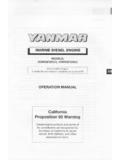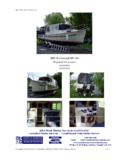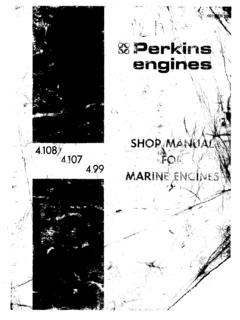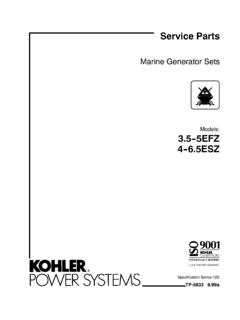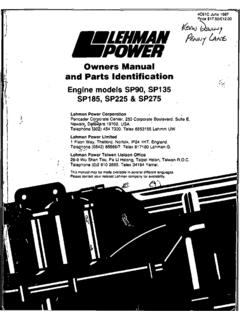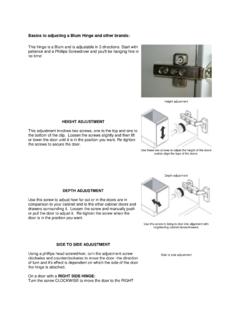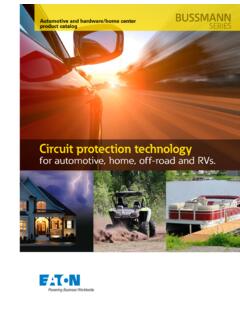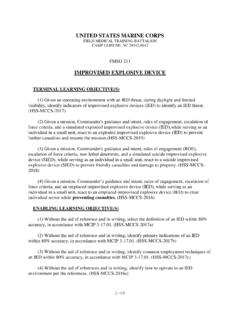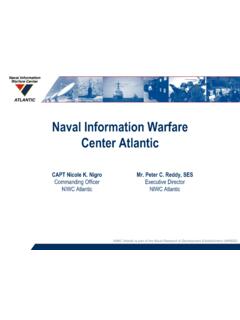Transcription of Volvo Penta Workshop Manual - Marine Surveyor Ontario
1 DrivesWorkshop Manual2(0)B C280, 280-DP, 285, 290, 290-DPSP-A, SP-C, DP-A, DP-B, DP-C1 General Information .. 3 Safety Information .. 3 Introduction .. 3 Important .. 3 General Information .. 6 About the Workshop Manual .. 6 Spare parts .. 6 Repair Instructions .. 7 Our joint responsibility .. 7 Tightening torques .. 7 Angular torque .. 8 Lock nuts .. 8 Strength classes .. 8 Safety instructions for fluororubber .. 9 Special tools .. 14 Drive models and generations .. 15 Design and function .. 19 Model 280 .. 19 Models 290-DP, DP-A, DP-B, DP-C .. 20 Removing the sterndrive .. 21 Models 280, 285 and 290 .. 21 Models SP and DP .. 25 Repair instructions .. 29 Upper gear housing .. 29 Disassembly, models 280, 285 and 290 .. 30 Assembly, models 280, 285 and 290 .. 35 Disassembly, models 290A, SP and DP .. 46 Assembly, models 290A, SP and DP .. 50 DrivesAQ 280, AQ 280-DP, AQ 285, AQ 290, AQ 290-DPSP-A, SP-C, DP-A, DP-B, DP-CContentsReconditioning the universal joint.
2 62 Reconditioning the shift mechanism .. 64 Types of shift mechanisms .. 64 Shift mechanism type 1 .. 64 Shift mechanism type 2 .. 66 Shift mechanism type 3 .. 68 Intermediate housing .. 73 Reconditioning the intermediate housing,model 280, 285 and 285A .. 75 Reconditioning the intermediate housing,model 290 and 290A .. 79 Reconditioning the intermediate housing,models SP and DP .. 82 Lower gear .. 86 Reconditioning the lower gear,models 280, 285, 290 and SP .. 90 The propeller shaft .. 93 Shimming .. 94 Final assembly .. 98 Reconditioning the lower gear,models 280-DP, 290-DP and DP .. 99 Inner propellershaft .. 102 Outer propeller shaft .. 102 Propeller shaft bearing box .. 103 Forward gear .. 104 Vertical shaft .. 105 Shimming the lower gear to the 120 Shimming the upper gear to the 122 Pressure and vaccum testing .. 1242 ContentsInstalling the sterndrive .. 125 Models 280 and 285 .. 125 Checking and adjusting controls.
3 127 Checking the retaining pawl whentest running .. 127 Oil filling .. 128 Propeller installation .. 128 Installing a long hub type of propeller .. 128 Installing a short hub type of propeller .. 128 The duoprop (earlier model) .. 129 Changing the direction of the 129 The electro-mechanical sterndrivetilting device (model 280) .. 130 Repair instructions .. 130 Reconditioning the tilting device .. 131 Model 290, SP and DP .. 132 Adjusting the retaining pawl (model 290) .. 137 Oil filling .. 137 Propeller installation .. 138 Installing a long hub type of propeller .. 138 Installing a short hub type of propeller .. 138 Changing the direction of the 139 Adjustment of the trim fin .. 140 Twin engine installation .. 140 Transom shield .. 142 Changing trim cylinders, model 290, SP and DP .. 142 Chanching steering helmet .. 147 Trim system .. 150 Changing the sending unit .. 150 Changing the trim system gear rack.
4 151 Changing the trim system gear wheel .. 153 The power trim pump .. 155 Removing the trim pump from the boat .. 156 Removing the oil reservoir .. 156 Replacing filters .. 156 Removing the electric motor .. 157 Installing the elctric motor .. 157 Replacing adapter and pump assembly .. 157 The relief valve assemblies .. 158 Installing the trim pump in the boat .. 158 Venting system .. 158 Test .. 158 Adjusting the trim instrument .. 158 Checking the trim figure .. 159 Adjusting the trim figure .. 159 Sterndrive extensions .. 160 Installation instructions for 1 and 4 extensions .. 160 The 4 extension .. 160 The 1 extension .. 162 Parts that cannot be welded .. 162 Parts which can be welded .. 162 Repair instructions .. 163 Preparing the sterndrive .. 163 Painting the underwater hull .. 163 Electrical wiring diagrams .. 164 Model 280 Tilting device .. 164 Model 280, Power trim .. 165 Model 290, Power trim (earlier model) .. 166 Models 290, SP and DP, Power trim (later model).
5 167 Technical data .. 168 Models 280, 280T, 280PT, 285, 285A and 290 .. 168 Models 280-DP, 280-DP/PT, 290-DPand 290A-DP .. 170 Models SP-A, SP-A1, SP-A2 and SP-C .. 173 Models DP-A, DP-A1, DP-A2, DP-B, DP-B1,DP-C and DP-C1 .. 174 References to Service Bulletin .. 1763 Safety InformationIntroductionThe Workshop Manual contains technical data, de-scriptions, and repair instructions for the designatedVolvo Penta products or product versions. Make surethat the correct Workshop literature is the following safety information and theGeneral Information and Repair Instructions inthe Workshop Manual carefully before startingservice a rule, all service work should be performedon an idle engine. Some work, certain ad-justments, require the engine to be an engine that is running is asafety risk. Remember that loose clothes orlong hair can fasten in rotating parts and causesevere careless movement or dropped tool whileworking in the vicinity of an engine that is run-ning, can in the worst case lead to injury.
6 Ob-serve caution on hot surfaces (exhaust pipe,turbo, charge air pipe, starter element etc.) andhot fluids in the lines and hoses of an enginethat is running, or has just been started. Refitall guards dismantled during service work be-fore starting the sure that the warning or information de-cals on the product are always clearly labels that have been damaged orpainted start the engine unless the air filter is fit-ted. The rotating compressor wheel in the turbocan cause severe injury. Foreign objects in theinlet pipe can also damage the use starter spray or the like. Explosionrisk in the inlet pipe. Risk of personal opening the coolant filler cap when theengine is hot. Steam or hot coolant can sprayout, and built up pressure will be lost. Open thefiller cap slowly and release the overpressurein the cooling system if the filler cap or cockmust be opened, or if a plug or coolant pipemust be removed when the engine is or hot coolant can flow out in an unpre-dicted oil can cause burn injuries.
7 Avoid skin con-tact with hot oil. Make sure that the oil systemis not pressurised before working on it. Neverstart, or run the engine with the oil filler cap re-moved in view of the risk of ejecting following special warning symbols are used in theWorkshop Manual and on the ! Warns of risk of bodily injury, seri-ous damage to product or property, or that a se-rious malfunction can occur if the instructionsare not ! Used to attract attention to thingsthat can cause damage or malfunction to prod-uct or ! Used to attract attention to important informa-tion, to simplify work procedures or following list provides an overview of the risksand cautionary procedures that should always be the engine from being started by dis-connecting the power with the main switch( switches ) and locking it (them) in disconnectedmode before the service work is begun. Attacha warning sign in the InformationStop the engine and close the bottom valve be-fore working on the cooling start the engine in a well-ventilated fumes and crankcase gases should beled out of the engine compartment or workshopwhen working in closed use protective glasses for work wherethere is a risk of splintering, sparks, or splash-ing of acid or other chemicals.
8 The eyes areextremely sensitive, and an injury can causeblindness!Avoid skin contact with oil! Prolonged or fre-quent skin contact with oil can degrease theskin, resulting in irritation, drying out, eczema,and other skin complaints. Used oil is more dan-gerous than new oil from the health care point ofview. Use protective gloves and avoid oildrenched clothes and rags. Wash your handsregularly, especially before meals. Use specialhand cream to counteract drying out, and tosimplify cleaning the majority of chemicals intended for theproduct ( engine and timing gear oils, gly-col, petrol and diesel oil) or chemicals for work-shop use ( degreasing agent, enamels andsolvents) are hazardous to health. Read the in-struction on the pack carefully. Always followthe given safety instructions ( the use ofbreathing protection, protective glasses, orgloves, etc.) Make sure that other personnelare not exposed to hazardous substances, inhaling the air. Make sure there is ade-quate ventilation.
9 Handle consumed and sur-plus chemicals in the prescribed extreme caution when tracing fuelleaks in fuel systems and when testing fuelnozzles. Wear protective glasses. The jet froma fuel nozzle has a very high pressure andpenetrating force. The fuel can penetrate deep-ly into bodily tissue and cause serious of blood fuels, in similarity with chemicals, are inflam-mable. Make sure that naked flames, orsparks, cannot lead to ignition. Petrol, certainthinners, and hydrogen from batteries, are ex-tremely inflammable and explosive when mixedwith air. Smoking is prohibited! Ventilate welland take the necessary precautions beforeconducting welding or grinding work in the im-mediate vicinity. Always have a fire extinguish-er handy in the sure that rags drenched in oil and petrol,including old fuel and lubricant filters, arestored safety. Oil drenched rags can in certainconditions self-ignite. Old fuel and oil filters areenvironmentally hazardous waste, and togetherwith spent lubricant, contaminated fuel, paintresidue, solvent, degreasing agent and suds,should be handed in to a waste handling unitfor must never be exposed to nakedflames or electrical sparks.
10 Never smoke in thevicinity of batteries. Hydrogen develops whenbatteries are charged, which in combinationwith air forms an explosive gas. This gas ishighly inflammable and very explosive. Onespark from connecting the batteries incorrectlyis sufficient to cause the battery to explode andcause injury. Do not touch the connection whenstarting (risk of spark) and do not lean over confuse the plus and minus terminalswhen fitting the batteries. This can cause seri-ous damage to the electrical equipment. Checkthe wiring use protective glasses when chargingand handling batteries. The battery electrolytecontains strongly corrosive sulphuric acid. Onskin contact, wash with soap and plenty of wa-ter. If battery acid gets into the eyes, rinse im-mediately with water, and contact a doctor with-out the engine and switch off the power withthe main switch ( switches ) before working onthe electrical of the clutch should be conductedwhen the engine is InformationUse the lifting hooks mounted on the engine/reverse gear when lifting the drive unit.
